Related Research Articles

HMS Beagle was a Cherokee-class 10-gun brig-sloop of the Royal Navy, one of more than 100 ships of this class. The vessel, constructed at a cost of £7,803, was launched on 11 May 1820 from the Woolwich Dockyard on the River Thames. Later reports say the ship took part in celebrations of the coronation of King George IV of the United Kingdom, passing under the old London Bridge, and was the first rigged man-of-war afloat upriver of the bridge. There was no immediate need for Beagle, so she "lay in ordinary", moored afloat but without masts or rigging. She was then adapted as a survey barque and took part in three survey expeditions.
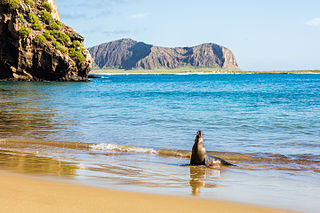
The Galápagos Islands are an archipelago of volcanic islands in the Eastern Pacific, located around the Equator 900 km (560 mi) west of South America. They form the Galápagos Province of the Republic of Ecuador, with a population of slightly over 33,000 (2020). The province is divided into the cantons of San Cristóbal, Santa Cruz, and Isabela, the three most populated islands in the chain. The Galápagos are famous for their large number of endemic species, which were studied by Charles Darwin in the 1830s and inspired his theory of evolution by means of natural selection. All of these islands are protected as part of Ecuador's Galápagos National Park and Marine Reserve.
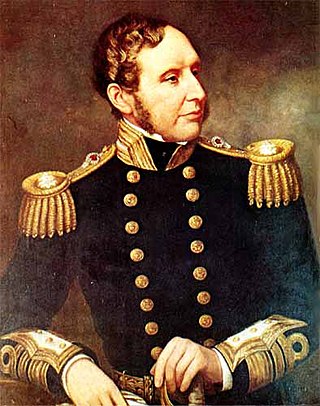
Vice-Admiral Robert FitzRoy was an English officer of the Royal Navy and a scientist. He achieved lasting fame as the captain of HMS Beagle during Charles Darwin's famous voyage, FitzRoy's second expedition to Tierra del Fuego and the Southern Cone.

The Voyage of the Beagle is the title most commonly given to the book written by Charles Darwin and published in 1839 as his Journal and Remarks, bringing him considerable fame and respect. This was the third volume of The Narrative of the Voyages of H.M. Ships Adventure and Beagle, the other volumes of which were written or edited by the commanders of the ships. Journal and Remarks covers Darwin's part in the second survey expedition of the ship HMS Beagle. Due to the popularity of Darwin's account, the publisher reissued it later in 1839 as Darwin's Journal of Researches, and the revised second edition published in 1845 used this title. A republication of the book in 1905 introduced the title The Voyage of the "Beagle", by which it is now best known.
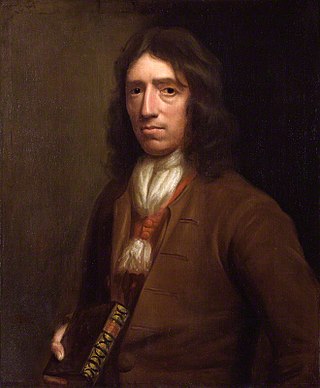
William Dampier was an English explorer, pirate, privateer, navigator, and naturalist who became the first Englishman to explore parts of what is today Australia, and the first person to circumnavigate the world three times. He has also been described as Australia's first natural historian, as well as one of the most important British explorers of the period between Sir Francis Drake and Captain James Cook ; he "bridged those two eras" with a mix of piratical derring-do of the former and scientific inquiry of the latter. His expeditions were among the first to identify and name a number of plants, animals, foods, and cooking techniques for a European audience, being among the first English writers to use words such as avocado, barbecue, and chopsticks. In describing the preparation of avocados, he was the first European to describe the making of guacamole, named the breadfruit plant, and made frequent documentation of the taste of numerous foods foreign to the European palate at the time, such as flamingo and manatee.

Darwin's finches are a group of about 18 species of passerine birds. They are well known for their remarkable diversity in beak form and function. They are often classified as the subfamily Geospizinae or tribe Geospizini. They belong to the tanager family and are not closely related to the true finches. The closest known relative of the Galápagos finches is the South American dull-coloured grassquit. They were first collected when the second voyage of the Beagle visited the Galápagos Islands, with Charles Darwin on board as a gentleman naturalist. Apart from the Cocos finch, which is from Cocos Island, the others are found only on the Galápagos Islands.

The Falkland Islands wolf, also known as the warrah and occasionally as the Falkland Islands dog, Falkland Islands fox, warrah fox, or Antarctic wolf, was the only native land mammal of the Falkland Islands. This endemic canid became extinct in 1876, the first known canid to have become extinct in historical times.

Harriet was a Galápagos tortoise who had an estimated age of 175 years at the time of her death in Australia. Harriet is one of the longest-lived known tortoises, behind Tu'i Malila, who died in 1966 at the age of 188 or 189; Jonathan, who remains alive at an age of 191, and possibly Adwaita, who died in 2006 at an estimated age of between 250 and 255 years. At the time of her death, she lived at the Australia Zoo which was owned by Steve and Terri Irwin.

Robert McCormick was a British Royal Navy ship's surgeon, explorer and naturalist.

Thomas Hornsey Bell FRS FLS was an English zoologist, dental surgeon and writer, born in Poole, Dorset, England.

Floreana Island is a southern island in Ecuador's Galápagos Archipelago. The island has an area of 173 km2 (67 sq mi). It was formed by volcanic eruption. The island's highest point is Cerro Pajas at 640 m (2,100 ft), which is also the highest point of the volcano like most of the smaller islands of Galápagos. The island has a population of about 100.

The Galápagos tortoise or Galápagos giant tortoise is a very large species of tortoise in the genus Chelonoidis. The species comprises 15 subspecies. It is the largest living species of tortoise, and can weigh up to 417 kg (919 lb). They are also the largest extant terrestrial cold-blooded animals (ectotherms).

The second voyage of HMS Beagle, from 27 December 1831 to 2 October 1836, was the second survey expedition of HMS Beagle, made under her newest commander, Robert FitzRoy. FitzRoy had thought of the advantages of having someone onboard who could investigate geology, and sought a naturalist to accompany them as a supernumerary. At the age of 22, the graduate Charles Darwin hoped to see the tropics before becoming a parson, and accepted the opportunity. He was greatly influenced by reading Charles Lyell's Principles of Geology during the voyage. By the end of the expedition, Darwin had made his name as a geologist and fossil collector, and the publication of his journal gave him wide renown as a writer.
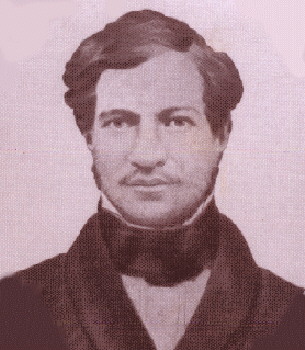
Syms Covington (1816–1861) was a fiddler and cabin boy on HMS Beagle who became an assistant to Charles Darwin and was appointed as his personal servant in 1833, continuing in Darwin's service after the voyage until 1839. Originally named Simon Covington, he was born in Bedford, Bedfordshire, England, the youngest child of Simon Covington V and Elizabeth Brown. After Covington's trip on the Beagle, he then emigrated to Australia and settled as a postmaster, marrying Eliza Twyford there.
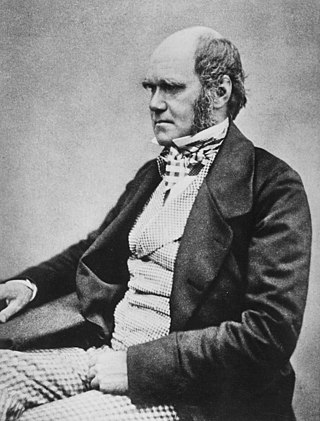
Charles Robert Darwin was an English naturalist, geologist and biologist, widely known for his contributions to evolutionary biology. His proposition that all species of life have descended from a common ancestor is now generally accepted and considered a fundamental concept in science. In a joint publication with Alfred Russel Wallace, he introduced his scientific theory that this branching pattern of evolution resulted from a process he called natural selection, in which the struggle for existence has a similar effect to the artificial selection involved in selective breeding. Darwin has been described as one of the most influential figures in human history and was honoured by burial in Westminster Abbey.

William Ambrosia Cowley, also known as Ambrose Cowley and Captain Cowley, was a 17th-century English buccaneer who surveyed the Galápagos Islands during his 1683–1686 circumnavigation of the world while serving under several captains such as John Eaton, John Cook, and later Edward Davis. Cowley drafted the first chart of the islands in 1684, first published with the account of his voyage in 1699. In his diary he reported the discovery of the phantom Pepys Island, allegedly situated north of the Falkland Islands, prompting a number of mariners to look in vain for the nonexistent rock.

The Structure and Distribution of Coral Reefs, Being the first part of the geology of the voyage of the Beagle, under the command of Capt. Fitzroy, R.N. during the years 1832 to 1836, was published in 1842 as Charles Darwin's first monograph, and set out his theory of the formation of coral reefs and atolls. He conceived of the idea during the voyage of the Beagle while still in South America, before he had seen a coral island, and wrote it out as HMS Beagle crossed the Pacific Ocean, completing his draft by November 1835. At the time there was great scientific interest in the way that coral reefs formed, and Captain Robert FitzRoy's orders from the Admiralty included the investigation of an atoll as an important scientific aim of the voyage. FitzRoy chose to survey the Keeling Islands in the Indian Ocean. The results supported Darwin's theory that the various types of coral reefs and atolls could be explained by uplift and subsidence of vast areas of the Earth's crust under the oceans.

HMS Blonde was a 46-gun modified Apollo-class fifth-rate frigate of 1,103 tons burthen. She undertook an important voyage to the Pacific Ocean in 1824. She was used for harbour service from 1850 and was renamed HMS Calypso in 1870, before being sold in 1895.

The era of European and American voyages of scientific exploration followed the Age of Discovery and were inspired by a new confidence in science and reason that arose in the Age of Enlightenment. Maritime expeditions in the Age of Discovery were a means of expanding colonial empires, establishing new trade routes and extending diplomatic and trade relations to new territories, but with the Enlightenment scientific curiosity became a new motive for exploration to add to the commercial and political ambitions of the past. See also List of Arctic expeditions and List of Antarctic expeditions.

A Voyage to the South Sea, and Round the World is a 1712 book by Edward Cooke, about a real-life circumnavigation of the Earth in two ships, under the command of Woodes Rogers. It is notable for including a firsthand account of castaway Alexander Selkirk, whose tale appears to have helped inspire Daniel Defoe to write Robinson Crusoe a few years later.
References
- ↑ Dampier, William. A New Voyage Round the World (Project Gutenberg ed.). Retrieved 21 February 2022.
- 1 2 Thomas, Nicholas (2020). "Introduction". William Dampier's A New Voyage Round the World (Penguin Classics ed.). London: Penguin Books. ISBN 978-0-241-41328-9.
- ↑ "European exploration – Westward voyages to the Pacific" . Encyclopaedia Britannica.
- ↑ Darwin, Charles (1860). "Chapter XVII: Galápagos Archipelago". Journal of Researches into the Natural History and Geology of the Countries Visited during the Voyage of HMS Beagle Round the World. London: John Murray. pp. 372–401 – via Wikisource. p. 399:
Tameness of the Birds
- Dampier, William (1968) [First published 1928]. A New Voyage Round The World . With an introduction by Albert Gray; and with a new introduction by Percy G. Adams (Reissued ed.). New York: Dover Publications. p. 77.
There are great plenty of Turtle-Doves so tame, that a Man may kill 5 or 6 dozen in a Forenoon with a stick.
- Dampier, William (1968) [First published 1928]. A New Voyage Round The World . With an introduction by Albert Gray; and with a new introduction by Percy G. Adams (Reissued ed.). New York: Dover Publications. p. 77.